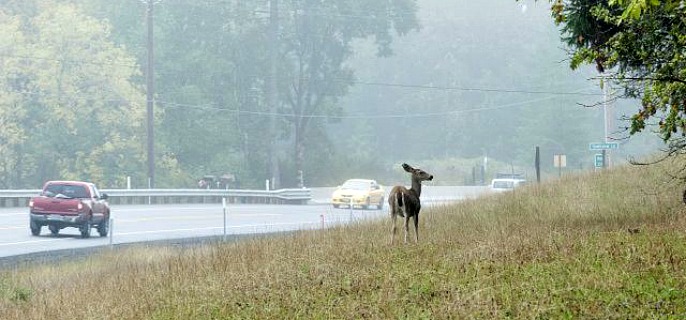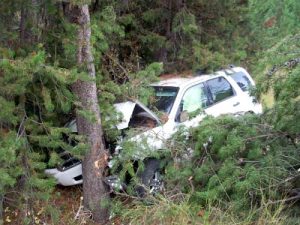
PHOTOS COURTESY OF OSP
October and November are the two busiest months for vehicle-wildlife collisions, statewide and nationally. With more wildlife crossing roads all over the state, Oregon State Police (OSP), Oregon Department of Transportation (ODOT), and Oregon Department of Fish & Wildlife (ODFW) urge motorists to be on alert.
According to statistics from ODOT’s Crash Analysis & Reporting Section, wildlife-involved traffic collisions have been on the rise in Oregon. In 2013, ODOT received reports of 1,274 such crashes, similar to the 1,283 crashes reported in 2012 and up from 1,199 reported in 2011. Overall, reports are approximately 24 percent higher than in 2008 (974 reported crashes). Officials believe the numbers are actually higher because most collisions involving wildlife result in property damage only to the involved vehicle and do not get reported to police or DMV.

• On Sept. 27, 2014 at approximately 6:43 a.m., a sport utility driven by a 22-year old woman was northbound on Highway 7 near milepost 3 in Grant County when an elk crossed the highway. The driver swerved to miss the elk, lost control and went off the highway where her vehicle collided head-on into a tree. The driver was transported by ambulance to an area hospital for treatment of non-life threatening injuries.
• On Sept. 27, 2014 at approximately 6:48 a.m., a vehicle traveling eastbound on Highway 26 near milepost 134 in Grant County struck an elk crossing the highway. The injured elk was found in a field off the highway and dispatched due to its injury. The driver wasn’t injured.
• On Sept. 29, 2014 at approximately 2:22 a.m., a passenger car traveling northbound on Highway 97 near milepost 191 in Klamath County struck a deer crossing the highway. The vehicle was damaged and had to be towed from the scene. The vehicle’s airbags deployed and the driver was uninjured.
• On Oct. 1, 2014 at approximately 9:30 p.m., two women received minor injuries while traveling eastbound on Interstate 84 near milepost 236 in the Meacham area when their passenger car struck an elk in the traffic lane.
ODOT statistics indicate since 2004 there have been more than 9,800 reported wildlife-involved collisions in Oregon, resulting in 29 fatalities; 12 of those fatalities were motorcyclists or motorcycle passengers. Fall weather often encourages motorcycle trips, so these operators should be especially vigilant: just as you continually watch for vehicles entering the roadway, be alert for wildlife, who when startled may even go back across a road they just crossed.
Over the past 10 years, more than a third of the total reported vehicle-wildlife crashes occurred September – November. The deadliest encounters have taken place in Josephine and Deschutes counties, but no county in the state is untouched by these incidents. Those with the highest total crashes reported are Deschutes, Douglas, Jackson, Klamath and Lane – and many crashes go unreported.
During this season, OSP, ODOT and ODFW urge drivers to be aware of the possible dangers associated with animals on or near our highways. Extra vigilance is required. The following information may help reduce these incidents:
• The annual deer rut season typically lasts from late October to mid-to-late November, increasing deer activity in and around roadways.
• During the next few months there will be fewer daylight hours and visibility will be challenged by darkness and winter weather conditions.
• Be attentive at all times, but especially sunset to sunrise.
• When driving in areas that have special signs indicating the possible presence of animals/wildlife, please use extra caution because these signs are posted for a reason.
• Be extra careful in areas where there is a lot of vegetation next to the road or while going around curves. Wildlife near the road may not be visible.
• Remember that the presence of any type of animal/wildlife could also mean that others are nearby.
• When you see an animal/wildlife near or on the roadway, reduce your speed and try to stay in your lane. Many serious crashes are the result of drivers swerving to avoid wildlife or other obstacles and they crash into another vehicle or lose control of their own vehicle.
• The same advice applies for smaller wildlife like nutria or raccoons – try to stay in your lane and do not swerve for these animals. They are less dangerous to vehicles than big game animals; losing control of your vehicle is a larger concern.
• Always wear your safety belt, as even the slightest collision could result in serious injuries.
ODOT produced a 2:30 video on the U.S. 97 undercrossing south of Bend showing elk and deer (and other animals) using the underpass and helping improve safety in a high-incident area. The video is available for viewing online.
More Stories from Northeast Oregon Now:
BMCC to Give Bond Measure Another Shot
Hermiston Library Book Sale Begins Thursday Night








